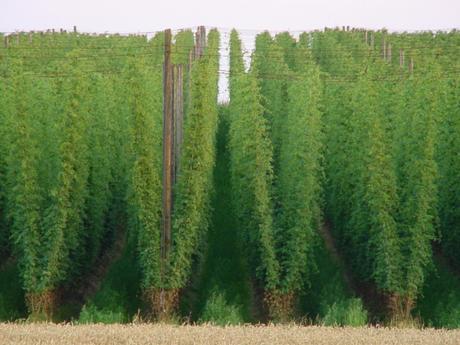
What better kind of "end of year" review than one related to hops, the national treasure of our beer loving country?
Another annual report was released this week, this time from the USDA, providing updated statistics that further show glimpses into our ongoing love affair with whatever will give our IPAs that "juicy" flavor everyone is seeking these days. While last year's darling might have been Mosaic, there's no question who the belle of the ball is this time around.
2016 appears to be Citra's year.
But before we get to that excitement, several charts to give a lay of the land.
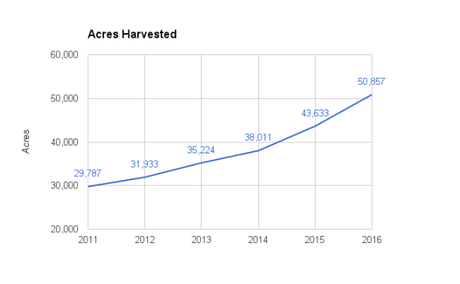
The number of hop acres harvested has steadily gone up, to no surprise. Looking past the obvious need for more hops as the US beer industry has grown, the agricultural sector has been happy to oblige by adding more farms across the country. The supply chain is only going to need to grow, as the average amount of hops per barrel, as reported to the Brewers Association, rose from 1.39 last year to 1.5 pounds this year.
By virtue of that, of course we're going to see more hops harvested than ever.
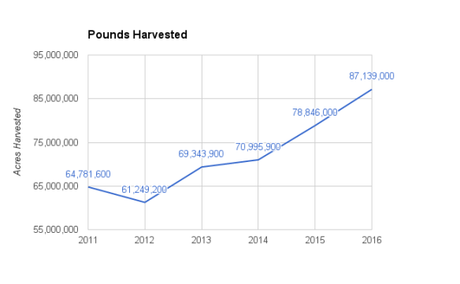
It's something of a simple "if A than B" situation here, as we have more acres being planted and harvested, so more pounds of hops comes along with it. When looking at this chart, it's important to note, however, what kind of hops are being grown.
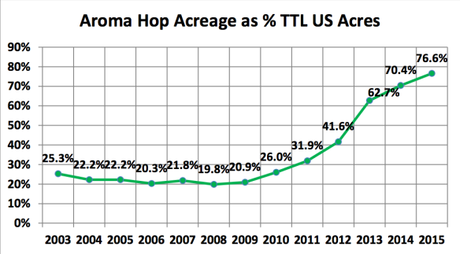
This chart cuts off before this past year, but we are likely safe to assume the trend line continued to move upward. Look for the potential in a big jump in coming years, as Simcoe (dual hop) and Amarillo (aroma) have patents expiring in 2019 and 2020, respectively.
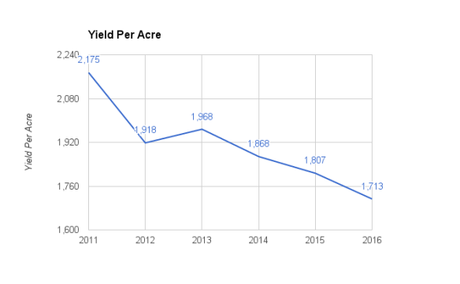
Ah, but here's where things get interesting. The increase in harvest doesn't tell the whole story, as the yield of hops per acre has dropped steadily in recent years. Part of that is because of the increased planting of lower yield varieties that are sexier for brewers and drinkers and can fetch higher prices.
For comparison's sake, here's the final tally of 2016 production versus mid-year projections:
According to the USDA, the 2016 value of the US hop crop totaled $498 million in 2016, up 44 percent from a record 2015 value of $345 million. The increased value is a factor of all the above: more hop acreage and production, and the continued shift from alpha varieties to aroma varieties that are higher in value.

Hope you don't mind paying a little more for those dank NE IPAs you've been drinking.
But what exactly are the hops driving the market? Or, perhaps a better question to ask in terms of availability and price, what are the hops that brewers want to use and people love tasting?
Looking at Beer Advocate's top-rated IPAs, I pulled a dozen brands that provided easily locatable ingredient information to see what hops were used in each batch. Tree House apparently doesn't release that information (internet forums made Julius easy), but that just means there's a wide cross section of beers to highlight:
Tree House Julius
Kern River Citra
Aslin Orange Starfish
Maine Beer Dinner
Bissell Brothers Swish
Lone Pint Yellow Rose
Trillium Fort Point
New England Fuzzy Baby Ducks
Grimm Lumen
Toppling Goliath King Sue
Surly Todd the Axe Man
Other Half Mosaic
Of the dozen listed above, 10 had Citra included in its hop bill. Three (Swish, Todd the Axe Man and Lumen) also had Mosaic, last year's beloved hop, and Other Half's Mosaic IPA is obviously all in on the latter. Simcoe also popped up for Dinner and Swish.
While these hops are gracing the best IPAs people are drinking, here's their growth pattern in acres harvested in recent years:
I imagine if it weren't for proprietary licensing on varieties like these, those numbers would shoot through the roof.
These hops are popular and trendy, but there's certainly more to the hop crop than what they offer. Courtesy of the Brewers Association, here's an updated look at the shifting rank of varieties from 2007 to 2014:

For an up-to-date listing, the BA also shared the top hops of 2016, with their production rank from 2015 in brackets:
If you want to know more about the state of the US hop industry and where things are headed (and most important, should head), may I recommend my series of posts from " Hop Week," which took place in September:
Bryan Roth
"Don't drink to get drunk. Drink to enjoy life." - Jack Kerouac

